Alocasia odora



Soft wooded
No secondary (woody) tissue being formed. The texture is fleshy and is soft, easy to cut.
Clumping
A plant that when multiplies forms a clump.This large rhizomatous perennial has a stout dark green trunk with long stalked large arrow-shaped glossy green leaves. Throughout the year fragrant green spathes appear followed by reddish fruit.
Alocasia odora (Lodd.) Spach. is naturally found in tropical southeast Asia from India to Myanmar, Cambodia, China, Japan (Ryukyu Islands) and Thailand. It grows in subtropical moist lowlands around swamps or along river embankments and in rainforests or bamboo thickets on hillsides, appearing from sea level to an altitude of 1,700 m (5,577 ft). It prefers a well to poorly drained reliably moist organic rich sandy-silty to loamy soil that is acidic to neutral with a pH range from 5.0 to 7.0. It grows in a sunny to semi-shaded humid wind protected position and is drought and frost tender with a preferred minimum winter temperature of 15ºC (60ºF).
The Sweet Alocasia is a large plant that is grown for its foliage and its clumping habit. It is planted in tropical gardens around water features or used in the understory of rainforests. It is also grown in boggy to wet positions along borders or as a specimen for a tropical effect. In cold regions it is grown in pots and or tubs as a glasshouse or conservatory specimen. It tolerates cooler weather where it re-shoots from the rhizome in spring and has a vigorous growth rate establishing from division in 1 to 2 years. It is larger than the other species in the genus so care should be take allowing enough room when selecting a position. Once established it has a high water requirement (Scale: 3-drops from 3), preferring organic rich deep soil that is reliably moist and tolerates periodic inundation.
I.D. 1342
UK hardiness zone H1a
Climate zones H1, 22-24
USDA Zone 8-11
Alocasia (a-loh-KAY-see-uh) odora (oh-DOR-uh)
Etymology
Genus: - Greek - Alocasia – from ‘a’ meaning (without) and ‘Colocasia’ derived from a closely allied genus
Species:-Latin odora – meaning (fragrant) referring to the fragrant spathes (flowers)

Tropical southeast Asia
Araceae (a-RAY-see-ee)
The Aroids normally appear in the tropics and is easily identified by their leafy spadix.
Distribution
These plants are found in the tropics, sub-tropics and temperate areas of the world. They are represented as terrestrial, epiphytic, aquatic and commonly live in marsh environments.
Diagnostic Features
The plants in this family are herbs, climbing shrubs and floating aquatics. The sap may be a latex form and the stem may be aerial, tuberous or rhizomatous in varying size.
The roots are either feeding type or clinging type and often aerial.
The leaves normally have a hastate base and are palmate to pinnate in shape and sometimes of forming holes.
The protogynous flowers are hermaphrodite or unisexual and monoecious; they are massed together on a cylindrical spadix that is enclosed with a leafy spathe. There may be 6-perianth segments, which are difficult to see with 6-stamens that unite, into units called synandria.
The ovary is superior with 1 to many chambers that contain 1 to many ovules.
The fruit is normally a berry and the seed may not have endosperm.
Note:
The South American Aroids are colourful, with spectacular foliage and commonly used as indoor plants. The Australian species are less dramatic and have been used as a food source.
This plant tolerates between USDA zones 9a to 11a and grows to 5 m (15 ft)
Fahrenheit 20º to 45º F
These temperatures represent the lowest average.
Celsius -6.6º to 7.2º C

Attention
This plant was last revised on the 30/05/2019
The information displayed on this plant is based on research conducted in our horticultural library and from reliable online resources. We also make observations of the plant that we photograph, and all care is taken to ensure the details are correct.
All photographs and data are covered by copyright. Apart from any fair dealing for the purpose of private study, research, reference or review, as permitted under the Copyright Act, no part including images and text may be reproduced by any means without written permission. The information presented in the map is only indicative and may contain errors and omissions. All inquiries should be addressed to sales@plantfile.com attention Peter Kirkland.

Simple
The leaf that is not divided.
Ovate
The leaf that is broadest at the base tapering towards the apex.
Spiral
Leaves arrangment is twisted like a screw.
Undulate
A leaf margin that is wavy.

Spadix
A spike with a fleshy-textured axis, the flowers are often partly embedded| Jan | Feb | Mar | Apr | May | Jun |
| Jul | Aug | Sep | Oct | Nov | Dec |
The flowers are produced in a fragrant leaf-like spathe that is up to 40 mm (1 5/8 in) long on a stem up to 140 mm (5 ½ in). In warm climates the flowering period is sporadic throughout the year but generally it is during summer.

Berry
A fleshy succulent indehiscent fruit, contains one or more seeds"The Sweet Alocasia is a large plant that is grown for its foliage and its clumping habit. It is planted in tropical gardens around water features or used in the understory of rainforests. It is also grown in boggy to wet positions along borders or as a specimen for a tropical effect. In cold regions it is grown in pots and or tubs as a glasshouse or conservatory specimen. It tolerates cooler weather where it re-shoots from the rhizome in spring and has a vigorous growth rate establishing from division in 1 to 2 years. It is larger than the other species in the genus so care should be take allowing enough room when selecting a position
Note:
This plant is susceptible to Bacterial Leaf Spot.
Sow fresh seed and maintain a temperature of 19º to 24º C (66º to 77º F). Divide established clumps (rhizome) or offsets during spring.
Propagation by seed (General)
Germination
In order for a seed to germinate it must fulfil three conditions.
1. The embryo must be alive (a viable seed).
2. The seed must have no dormancy-inducing physiological, physical or chemical barrier to germination; also the seed must be nondormant.
3. The seed must have the appropriate environmental requirements, water, temperature and oxygen.
The interaction between these requirements and dormancy is complex and may lead to different environmental requirements that avoid the dormancy of a seed.
Sowing seeds in containers
There are two general methods for germinating seeds.
Sow seeds in a flat or germinating bed, through which seedlings are pricked-out then, transplanted into another flat with wider spacing or directly to an individual pot.
2. Sowing seeds by placing them in to flats with the appropriate spacing or into individual pots.
This method is normally carried out with medium to large seeds such as woody plants and plants that are difficult to transplant.
Seedling production normally occurs in a greenhouse / glasshouse, cold frames and on hot beds.
Method of seed sowing
Fine seed is sown in pots or flats that are no deeper than 70 to 80 mm (3 1/8 in). using a sterilised well-drained media (soil). Fill the container to 20 mm (¾ in) from the top and sprinkle sieved peat to 3 mm (1/8 in) depth. Press the media down level and firm with a piece of timber and then thoroughly moisten.
Mix the fine seed with washed sand and then sow thinly on the surface. These may be lightly covered with sand.
Larger seeds may be covered with media or a hole is dibbled and the seed is placed in the media.
Watering methods
For watering you may either mist the containers from above or place the container in tepid water and allow the water to raise through the pot to the surface of the media, then drain away and do not fill to the top of the container.
Place a piece of glass over the pot and store in a protected warm environment (glasshouse).
Seeds germinate best in darkness so shade the containers if in direct sunlight.
After the seedlings have sprouted remove the glass and ease the seedlings into direct light.
When the seedlings are large enough prick them out and transplant into larger containers then place them in a shade house to harden off.
Many seeds have different methods of seed preparation for germination such as nicking or cutting the seed coat to allow water penetration, also placing seeds in hot water and allowing it to cool off.
This is particularly important as it is softening the seed coat.
Offsets
This is a lateral shoot that forms from at the base of the mother plant. Often referred to in bulbs as bulblets or lateral branching in monocotyledons and appear as thickened stems and are removed close to the main stem. These natural methods are slow but microporpagation in aseptic culture has greatly enhanced production.
Rhizomes
A rhizome is a stem that grows horizontally either below or on the surface of the soil with the shoots growing vertically as in bamboo and many grasses. The stems are composed of nodes and inter nodes giving it a segmented appearance.
Propagation is normally carried out by division during spring and autumn, by cutting the rhizome into sections each with at least one node. Placed on a moist bed or slightly buried and kept warm will produce roots and shoots from the nodes.
PEST
NAME
Mealybugs
Various Mealybug Species
ORDER
Hemiptera
FAMILY
Pseudococcidae
Description of the Pest
Adult females are 3-5mm long, flattened oval-shaped white insects, which secrete a white, mealy wax that forms a row of hair-like filaments of fairly uniform length around the edge of the body; the hind end bears one or two pairs of filaments that are longer than the others. They are mobile but slow-moving. The seldom-seen adult males are tiny winged insects with a pair of long waxy tail filaments. Early stage nymphs are tiny, pink and mobile; later stages resemble adult females.
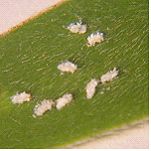
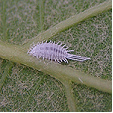
There are many types of mealybugs including;
· Longtailed Mealybugs (Pseudococcus longispinus) generally have tail filaments that are longer than there body. If squashed yellow body fluid is revealed and the eggs are laid under the body and normally hatch immediately.
· Citrus Mealybug (Planococcus citri). This insect has tail filaments that are less than 1/3 the length of its body. It produces yellow orange body fluid and lays eggs in a cottony mass.
· Citrophilous Mealybug ( Pseudococcus calceolariae). This insect has tail filaments that are about 1/3 the length of its body. It produces dark red body fluid and the eggs are laid in a cottony sac.
· Root Mealybug (Rhizeocus falcifer). This insect is not normally seen but produces a open white mass as it feeds on the outer or terminal roots, normally container plants, particularly cacti species. The eggs are laid in the waxy mass and adults may dispersed by ants.
· Hibiscus Mealybug (Maconellicoccus hirsutus)
· Tuber Mealybug (Pseudococcus affinis)
The Mealybugs (Pseudococcus adonidum) and (Planococcus citri) are a major pest of cacti species, sucking sap and turning the infected area yellow. These pests are also found on Strelitzia, Camellia and Yucca species.
Appearance and Distribution of the Pest
Mealy bugs are found worldwide. The above ground species are found in sheltered areas such as under a leaf or in leaf bases. They are also found where two fruits or leaves touch and are not readily noticeable.
The below ground species are only found when a plant is re-potted or the infected plant wilts and dies. Mealybugs are distributed several ways including slowly walking to a new host or transferred on clothing, contaminated plants or strong wind and on visiting insects. They are also farmed by ants which in a nursery situation infest pots by tunnelling and carrying mealybugs to the roots.
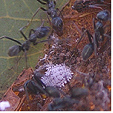 Attending Ants
Attending Ants
Life Cycle
These insects have a Hemimetabolous life cycle, ie. When the immature nymphs resemble the adults.
Up to 200 young are produced in 2-3 weeks; eggs may hatch as they are being laid. The life cycle includes eggs, nymphs (3 to 4 stages) to adult takes 6 weeks, in warmer months; several generations appear throughout the year.
Period of Activity
Active all year, particularly in spring and autumn. Warm, humid conditions are preferred and the insect overwinter outdoors as eggs. These may be found on surrounding weeds. In Citrus species many longtailed mealybugs overwinter as juveniles, maturing during spring. In a Glasshouse conditions mealybugs are active through the year.
Damage Caused
Adults and nymphs suck sap, congregating in sheltered parts of the plants; some species feed undetected on roots. Early infestations may go unnoticed until the plant begins to wilt. The insect also produces honeydew, which gives rise to sooty mould.
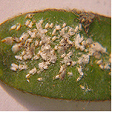
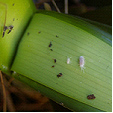 Clivia miniata
Clivia miniata
Susceptible Plants
Mealybugs are found on a wide variety of trees and shrubs. They are also destructive to many ornamentals; including indoor plants (especially African violets and ferns), and are a major greenhouse pest.
Cactus species
Many species of mealybug are common pest of cactus and succulents. The small, grey to light brown mealy bugs are difficult to see amongst the spines. Nesting females appear as the small balls of white fluff on cactus spines or around the base and under the rim of the pots. The female will produce eggs or living nymphs and the insect will produce honeydew that attracts ants. Ants should be discouraged as they farm mealy bugs, moving them from one place to another in a cactus collection.
Cactus is also attacked by the root mealybugs that infest the roots of plants and their damage allows fungal and bacterial infections to enter the plant tissue. They can be identified by white fluffy deposits in the soil or underneath a pot and appeared as tiny pinkish brown wood lice up to 3 mm long.
Catalpa species are susceptible to the mealybug (Pseudococcus comstocki) which is a wax covered mealybug that causes distorted growth of the branches and branchlets.
Fern species are commonly attacked by mealy bugs and can be recognised by small white, waxy secretions as it feeds in the crevices at vein junctions or on the exposed rhizome.
Hedera and Crassula species are susceptible to three species of mealybugs including Citrus Mealybug (Planococcus citri) and not normally requiring control.
Laburnum anagyroides is infested with the Grape Mealybug (Pseudococcus maritimus) infesting the branches and twigs.
Plumeria acutifolia becomes infested with mealybugs on the new growth but normally control is not required.
Psidium species are attacked by the Longtailed Mealybugs (Pseudococcus longispinus).
Sequoia species are attacked by three species of Mealybugs including (Planococcus citri).
Thymus species are attacked by the Root Mealybug (Rhizeocus falcifer).
Thuja species Cupressus macrocarpa and Araucaria heterophylla are can be infested with the mealybugs (Pseudococcus ryani).
Turf Grass may be infested with mealybugs causing severs damage and often go undetected and build up large colonies quickly. The turf forms brown dry patches and looks simular to Dollar Spot the infestation may also occur around core holes and can be discouraged by generous watering. Agrostis palustris (Bent) and Cynodon species (Couch) are commonly attacked.
Yucca species are attacked by the mealybug (Planococcus citri).
Cultural Control
Small plants may be sprayed with a soapy water solution or sponged down preferably during the evening. Heavily infected areas should be pruned and destroyed or the whole plant removed. Infested pot-plants should be discarded and thoroughly disinfect pots before recycling). Maintain vigour by watering to replace sap loss, this helps infected plants to recover.
As a preventative measure for root mealybugs grind up mothballs and add them to the potting mix to discourage infestations. Care should be taken as the chemicals in mothballs can damage plastic pots (use clay pots) and in some countries such as the UK. mothballs must be used as directed on the label.
Biological Control
Lacewing and ladybeetle larvae (Cryptolaemus montrouzeri) control small infestations. This predator insect requires temperatures of at least 21° C. (70°F) and in small infestations it is difficult to maintain a balance between predator and prey.
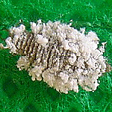
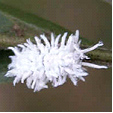
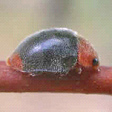
Ladybird beetle larvae eats Mealybugs Ladybird beetle up to 4 mm long
Chemical Control
Spray with white oil may have an effect on the population or spray Omethoate. Contact insecticides are usually ineffective because of the insect's protective waxy coating.
Note
Always read the label for registration details and direction of use prior to application of any chemicals.
DISEASE
NAME
Fungi (General)
Various Fungal species
Description
A fungus is a plant that lacks chlorophyll and conductive tissue. Generally they are made up of branched threads called 'hyphae' and collectively form a vegetative body called 'mycelium'. The fungus is small but the fruiting bodies can become very large up to 600mm across such as bracket fungi or mushrooms. Common fungi are mould and mildews. problem that attacks the roots causing them to rot.
Fungus can reproduce many ways but primarily it is asexually, simular to cuttings of a plant and often occurs with minute portions of the mycelium (spores) separating. The spores can be arranged in a structure such as a sporangia or pycnidia or develop without an enclosed structure called a "conidia". Either way the fungus propagates very rapidly. Sexually reproduction occurs when two nuclei unite and form sexual fruiting bodies (zygospore).
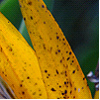 Strelitzia reginae flower
Strelitzia reginae flower
Symptoms
Fungus attacks all the above or below ground level parts of the plant living within the tissue of the plant and are very small and not normally detected until the fruiting body appears. However parasitic types such as powdery mildew or rust are visible on the outer surface of the plant.
Fungi hyphae may be divided by cross walls and known as "septate" while others with no cross walls are known as "nonseptate". These are the fungi responsible for cell leakage as in rot.
Back Mold (Chalariopsis thielavioides) affects understocks of grafted Rosa species by inhibiting the development of callus. It is whitish-grey maturing to black and can be found in the pith of the rose stem.
Black Root Rot (Chalara elegans).This recently introduced fungal disease in Australia (1993) affect plants by blackening the root systems and turning leaves yellow or purple. It is difficult to identify specifically as other pathogenic root diseases and nutritional deficiencies have simular characteristics.
The asexual spores are dispersed by wind or water. It is also transmitted on insects and in contaminated growing media or plants preferring humid moist conditions.
This fungus affects a wide range of ornamental plants including; annuals, perennials and shrubs. Examples are Begonia, Boronia, Camellia, Cyclamen, Fuchsia, Gerbera, Grevillea, Impatiens, Pansy, Petunia, Rosa species and Snapdragon.
Black Stem Rot (Pythium splendens) normally is a rot that occurs in cuttings turning the stem progressively black and shrunken. The leaves fall and the plant becomes stunted, eventually dieing.
Bleeding Necrosis (Botyosphaeria ribis) attacks and kills the inner wood causing the bark to split open and bleed sap giving it an oily appearance.
Blight (Endothia parasitica) is a serious pest of Castanea species, entering the twigs and small branches, and then progressively travelling throughout the tree killing it. It may form cankers on the base of the trunk or in the dead branches above with the amber coloured fruiting bodies pushing there way through the bark.
Copper Web ((Rhizoctonia crocorum). This fungal disease appears in defined patches causing the corms in the centre to become a black powdery mass. Corms on the outer ring of the patch that are partially infected forming a felty mass of violet threads on the corm scales. These threads extend into the soil and large sclerotia forms in the soil and on the corms. Healthy corms become infected from contaminated soil that contains mycelium and sclerotia.
Dry Rot (Phyllosticta concave) forms small circular spots that increase to a diameter of 30mm, and then becomes sunken as the cells collapse. The infected area develops minute black fruiting bodies.
Dutch Elm Disease (Ceratocystis ulmi) is a serious fungal problem of Ulmus species that initially causes yellowing then wilting of the leaves that turn brown and die. This may be seen on certain branches of the tree and on inspection under the bark the sapwood reveals brown streaks. A cross section of the affected branch displays round spots that are dark brown. This infection normally spreads quickly throughout, killing the tree in one to two seasons.
Dieback in Camellia (Glomerella cingulate) is a pathogenic fungus that infecting existing wounds such as leaf scars or mechanical damage, forming a sunken area (canker) that spreads around the stem causing die back. The affected plant has new shoots that are brown-black and the tips curl, forming a 'Shepard's Crook' appearance. The leaves also die but are persistent on the plant and the spores are found in soil or on other infected plants.
Curvularia Leaf Spot (Curvularia species) in Turf Grass. This is normally a secondary weak fungal infection that forms spots on the leaves that lengthens turning the leaves greyish. The leaf shrivels then dies and infected areas appear as weak patches in the turf. Preventive measures include minimising leaf wetness and excessive use of nitrogen fertiliser.
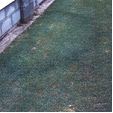 Fairy Rings Blue Couch
Fairy Rings Blue Couch 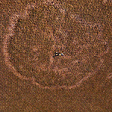
Fairy Rings are a fungal problem in Turf Grass and is caused by several species including (Lycoperdon species), (Marasmius species) and (Tricholoma species). Rings appear in the turf as fruiting bodies or dead grass and as lush green foliage. The mycelia expand radially in the turf feeding on soil nutrients and organic matter with water present.
Under severs conditions the mycelia consume all available nutrients resulting in the death of the turf. Lush turf can result from a less developed infection, where the decomposing hyphal releases nitrogen. This available nitrogen may be beneficial to the turf but some forms of nitrogen are detrimental.
Leaf Blister (Taphrina coerulescens) appears as yellowish circular raised areas on the upper side and depressions on the underside of leaves, up to 15mm across. As the fungus spreads the leaf dies but remains attached to the tree and this infection is commonly found on Quercus species..
Leaf Blotch (Guignardia aesculi) forms small or large water soaked spots that are reddish with a bright yellow margin and form black fruiting bodies in the centre. The affected leaf and petiole have a scorched appearance before falling, found on Aesculus species
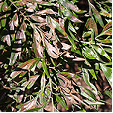 Grevillea robusta
Grevillea robusta 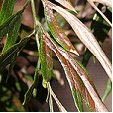 Leaf Scorch
Leaf Scorch
Leaf Scorch (Verrucispora proteacearum) is a fungal disease that infects leaves causing large parts of the leaf to turn grey-brown, giving the appearance that it has been singed by fire. Black fruiting bodies appear on the affected areas and the leaf soon withers then dies. New, mature leaves are affected during very wet periods towards the end of the branches and Grevillea and Hakea species are susceptible.
Melting Out (Helminthosporium vegans) forms bluish black spots with straw coloured centres on the leaves and may be found on the sheath, encircling it causing Foot Rot. It infects grasses particularly Poa pratensis. There is another fungus that is simular Helminthosporium Blight (Helminthosporium dictyoides) that infects Poa, Festuca and Agrostis species.
Pad decay (Aspergilus alliaceus) infects Cereus and Opuntia species and occurs at during periods of high temperature. The yellow spores at the epidermal layer through wounds and germinate on mass causing the area to become soft and spongy. An anthracnose called Shot Hole is a similar forming brownish spots the turn grey, and then black destroying pads. Control methods include physically removing damaged pads and allowing the Sun to heal wounds.
Potato Gangrene (Phoma foveate) is a soil borne fungus that infects the roots during harvest primarly through wounds and develops during storage. The potatoes rot from the inside forming rounded depressions on the surface and have a strong odour of rotten fish.
Root Rot Fungi (Phymatotrichum omnivorum) and (Pellicularia filamentosa) cause the roots to rot and the plant suddenly wilts then dies.
Root Rot (Pythium debaryanum) forms water soaked dark brown streaks that affect all parts of the plant causing wilting then dieing. It infects Ranunculus species, it also infects cactus species by forming brown spotting and wilting that appears at the base of the plant then extends towards the top. It quickly spreads from plant to plant in collections and is controlled by avoiding over watering, excessive humidity and are using a sterilised soil when potting up.
This fungus also is responsible for damping off of seedlings in a glasshouse environment.
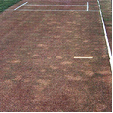 Spring Dead Spot
Spring Dead Spot 
Spring Dead Spot (Leptosphaeri species) is a fungal disease that infects Couch Grass. It first appears during autumn as pale bleaches areas up to 500mm (20in) wide and persists throughout winter. In spring the affected areas do not recover or recover slowly and on inspection the roots or rhizomes are rotted. Runners from the surrounding healthy turf will help with recovery and all signs of the problem disappear by mid summer.
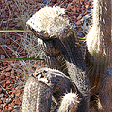 Cactus species
Cactus species 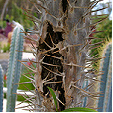 Pachypodium species
Pachypodium species
Stem Rot (Helminthosporium cactivorum) forms well defined yellow lesions that mature into soft dark brown rot. It commonly infects Cactus species entering through the stomates or wounds. Heavily infected plants collapse and die.
Stem Rot or Basal Rot (Pellicularia rolfsii) is a soil borne fungus that infects the stem root junction and extends into the leaves. In orchids the leaves become discoloured, dry and detach from the base which is covered in a fungal growth that produces sclerotia. The sclerotia is whitish to yellow then becoming dark brown and can be viable for up to four years.
White Mold (Ramularia desta f. odorati) occurs on both sides of the leaf and looks simular to powdery mildew but forms faint dull, reddish brown elongated spots on the leaf that may be depressed or along the margin where they have a watery appearance. Tufts of hyphae develop in the stomates.
Wilt (Ceratocystis fagacearum) causes leaves to curl then turn brown and the sap wood may also turn brown or black. Heavy infection may kill a tree within two seasons and is found on Quercus species and other ornamental trees.
Witches Broom may be a fungal problem that causes a proliferation of small axillary shoots to appear at the end of the branches. Little is known about this problem, though it affects a wide range of plants including Eucalyptus, Leptospermum and Pinus species.
Source and Dispersal
Fungus is found in the soil or on other infected plants and after releasing the spores, they are dispersed by wind or are transmitted in infected stock, insects and with splashing water.
Wilt is transmitted by infected root stocks, several species of insect and contaminated tools.
Dutch Elm Disease is transmitted by bark beetles such as (Scolytus multistriatus) and (Hylurgopinus rufipes). These beetles deposit eggs in the sapwood where the lava tunnel and pupate. The emerging beetles tunnel the bark and carry the fungus to fresh feeding sites on the tree. Infected beetles may also be transported to fresh sites in waist material.
Favoured Conditions
Prefers cool moist conditions with temperatures from 10º to 25ºC and is more common from autumn to spring when it is wet.
Affected Plants
A wide range of plants and all parts can be infected by various fungal diseases. Bleeding Necrosis is found in Liquidambar species and Stem Rot or Dry Rot infects Cactus species such as Opuntia and Pelargonium.
Abies species are infected by several fungi that cause Leaf Cast which turn the needles yellow to brown then fall prematurely.
Abutilon species are infected by the Stem Rot (Macrophomina phaseolin) affecting the lower stems and is not commonly seen.
Achillea, Cuphea, Leucanthemum, Euphorbia species are infected by the Stem Rot (Pellicularia filamentosa) which enters through the roots and rots the base of the stem.
Alternanthera species are infected by the Leaf Blight (Phyllosticta amaranthi) which forms small brown spots on the leaves causing them to curl and die.
Aloe, Astrophytum, Copiapoa, Echinocactus, Espostoa, Ferocactus, Gymnocalycium, Kalanchoe and Schlumbergerera species are infected by Bipolaris Stem Rot (Bipolaris cactivora). This infection affects many cacti species causing rot in the stems with a blackish appearance.
Amelanchler is affected by the Witches Broom (Apiosporina collinsii).
Antirrhinum species are infected by the Blight (Phyllosticta antirrhini) that forms light brown spots on the upper-side of the leaf and on the stem. As the spots enlarge they turn greyish with black fruiting bodies in the centre, then become brown and killing the affected areas.
Begonia species are infected by the Stem Rot (Pythium ultimum) turning stems black then becoming soft and causing the plant to collapse. This is the same fungus that causes Damping-off.
Betula species are affected by the Leaf Blister (Taphrina bacteriosperma) which curls the leaves and forms reddish blisters.
Chamaedorea and other cain-like species are infected with Gliocladium Stem Rot (Gliocladium vermoseni) which forms a dark basil stem rot generally on damaged plants and produces orange-pink spores. The mature leaves are first affected and eventually the stems or cains rot and die.
Crocus and Gladiolus species are infected by the Dry Rot (Stromatinia gladioli), which causes lesions on the corms and rots the leaf sheath.
Crocus, Iris, Tulipa, and Narcissus species are infected Copper Web ((Rhizoctonia crocorum).
Dianthus species are infected by Phialophora Wilt (Phialophora cinerescens) that causes the leaves to fade and plants to wilt. There is obvious vascular discoloration which is very dark. It is not found in Australia.
Erythrina x sykesii may be infected by the Root Rot Fungi (Phymatotrichum omnivorum).
Fern species are infected by Tip Blight (Phyllosticta pteridis). This blight produces ash-grey spots with purple brown margins and the fruiting bodies appear as black pimple like spots. It is transmitted by air or moisture and in infected fronds become brown and die. Control methods include sprang fungicide on leaves or reducing humidity and avoid wetting the fronds.
Forsythia species are infected by Stem Gall (Phomopsis species). It forms rounded growths along the stems causing them to die and look unsightly.
Gladiolus species are infected by Penicillium Rot of Corms (Penicillium gladioli). This disease forms deeply sunken reddish brown areas that become corky and produce a greenish fungal growth.
Hedera species are susceptible to several Fungal Leaf Spots including (Glomerella cingulate), (Phyllosticta concentrica) and (Ramularia hedericola). All of which cause yellowish spots that develop into dry brown blotches that kill the leaf.
Larix species are susceptible to Leaf Cast (Hypodermella laricis). This fungus attacks the needles and spur shoots turning them yellow at first then brown after which small black fruiting bodies appear on the leaves during winter.
There are several other fungi including (Cladosporium species) and (Lophodermium laricis) cause leaf blight or leaf casts.
Orchids such as Cattleya, Cymbidium, Cypripedium, Dendrobium, Epidendrum, Oncidium, Paphiopedilum, Phalaenopsis and Zygopetalum species are infected by Phomopsis Rot (Phomopsis species). This fungal problem forms a firm brown rot that appears on the leaves, pseudobulbs and rhizomes. The affected areas have yellow margins and the centre is covered in tiny black specks (fruiting bodies). Cattleya species are particularly susceptible. These plants are also infected by Psudobulb Rot (Mycolleptodiscus coloratus implicated). Dark spots appear on the pseudobulbs eventually causing extensive rot and killing the bulb.
Palms are infected by the fungus Butt Rot (Ganoderma sulcatum). The fungus entered the lower trunk normally as a result of mechanical damage (lawn mower). Symptoms include stunting of new growth and yellowing of the lower leaves. Fruiting bodies become evident at the base of the trunk. There is no effective control method and replanting in infected soil should be avoided.
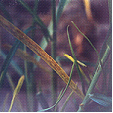 Kikuyu Yellows
Kikuyu Yellows 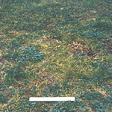
Pennisetum clandestinum (Kikuyu) is susceptible to Kikuyu Yellows (Verrucalvus flavofaciens), thisis a water mould that infects the roots and causes them to rot. The infection extends up the stem and onto the leaves with yellow discolouration and can be limited to a small or large area up to 1m (3ft) wide.
It is found in warm temperate to sub tropical regions and dispersed in infected soil or plant material. There is no chemical control, nitrogen fertiliser masks the symptoms and complete fertiliser encourages stronger roots to fight the disease.
Pittosporum, Antirrhinum, Aquilegia, Echinops and Orchid species are infected by the Stem Rot or Basal Rot (Pellicularia rolfsii) commonly in the northern hemisphere and preferring humid glasshouse conditions.
Solidago species are infected by the fungal Scab (Elsinoe solidaginis) which covers the leaves and stunts the growth of the plant. Young plants may be killed.
Trillium species are infected by the stem rot (Pellicularia rolfsii) and ( Ciborinia trillii). This normally occurs in wet soils and is detrimental to the plants life.
Tsuga species are infected by Sapwood Rot or Butt Rot (Ganoderma lucidum) and (Coniophora puteana), which attacks the sapwood close to the bark, towards the base of the tree. Commonly killing the host.
Tulipa species are affected Blue Mold (Penicillium species) and the fungus (Rhizopus stolonifer) causing rot in the bulbs.
Vinca species are infected by the soil born Root Rot (Pellicularia filamentosa) which rots the stems and roots.
Viola species may be infected with the Scab (Sphaceloma violae) which attacks all parts of the plant including the seed capsule forming yellowish spots that turn brown and in leaves fall out. Stems and petioles can be girdled killing the upper part.
Viola species are also infected with the Stem Rot (Myrothecium roridum) which attacks the stems at ground level causing them to become dry and brittle. The leaves show symptoms by turning purplish-black and this fungus also infects Alcea and Antirrhinum species.
Non-chemical Control
Generally remove and destroy any infected plants or plant parts, when replanting, avoid using susceptible species for 3 years. When growing crops space the plants to reduce the humidity and airflow and cultivate the soil to increase the drainage. Remove weed growth from around the susceptible plants.
Avoid over watering the surrounding soil which encourages fungal development. In the case of trees remove any infected branches and heavily infected trees should be cut down and removed. This infected material should be disposed or burnt. Damaged trees should have the wounds dressed and sealed as a preventative measure particularly for Dieback in Camellia.
Deter Potato Gangrene by planting clean stock and be careful not to damage the crop when weeding. When harvesting the tubers choose a dryer period and be careful not to damage them.

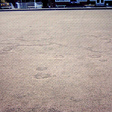 Fairy Rings
Fairy Rings
Fairy Rings in Turf are difficult to control and may appear or disappear sporadically. Cultural practice such as minimal thatch build-up, regular aeration and a reduction of organic matter spread on the turf will reduce infection.
Chemical Control
No suitable fungicides available, though drenching or spraying the soil with the fungicide dichloran helps control soil born fungi.
Note
Always read the label for registration details and direction of use prior to application of any chemicals.
DISEASE
NAME
Leaf Spot (General)
Various Leaf Spot Species
Description
There is a wide variety of fungal leaf spots that infect perennials, shrub and trees. Some are specific to the host while others can affect a range of plants.
Symptoms
Generally light brown to purplish or blackish spots appear on the leaf and form concentric rings of fruiting bodies. The spots may leave holes, perforating the leaf or expand with pale green to yellowish margins and when the holes merge the leaf normally dies. There are many different types of leaf spot, some are discussed below.
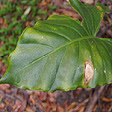 Alocasia species
Alocasia species 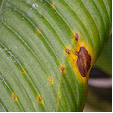
Alternaria Leaf Spot (Alternaria nelumbii) forms a small reddish brown spots that are boarded in light green, and as they develop in size the leaf curls and dies from the margin inwards. Normally occurs on Nelumbo species (water lilies).
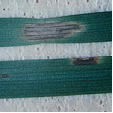 Helminthosporium Disease
Helminthosporium Disease
Helminthosporium Disease (Bipolris species), (Drechslera species) and (Exserophilum species) are responsible for several leaf spots that occur on all Turf Grass species. Generally they form black or white spots that may be faded and produce masses of spores in the thatch during late summer, under humid conditions. The life cycle is short and when conditions are favourable spores are splashed onto the foliage from the thatch, causing wide spread infection. Cynodon dactylon (common couch) is most susceptible and found in bowling or golf greens where it is a serious problem.
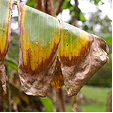 Banana Leaf Spot
Banana Leaf Spot 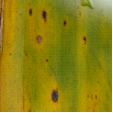
Banana Leaf Spot (Mycosphaerella musicola) is found on many species of banana causing pale yellow streaks on the young leaves to turn brown with dark spots. The leaf then becomes dried, brown and dead commencing from the margins, eventually the leaf dies. Control requires removal of infected foliage or the spraying of a fungicide and fungicides should not be used during the fruiting period.
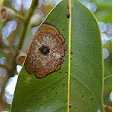
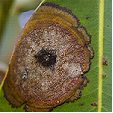 Lophostemon confertus (Brush Box)
Lophostemon confertus (Brush Box)
Leaf Spot on Brush Box (Elsinoe species). This is a casual fungus that attacks the epidermal layer of the leaf, forming circular spots that are up to 25mm across and are often restricted by the main vein. These spots are a dull yellowish brown but can also have purplish patterns. A leaf may have more than one spot develop on its surface and normally appears on scattered leaves throughout the tree. This doesn't affect the vigour of Lophostemon confertus.
Palm Leaf-scab (Graphiola phoeicis) appears as yellow spots and develop into scabs or warts that are outwards hard and dark but with a soft centre with powdery yellowish brown spores. The infected leaves eventually die.
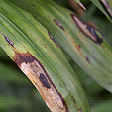 Palm Leaf Spot, Chamaedorea elegans
Palm Leaf Spot, Chamaedorea elegans
Palm Leaf Spot (Pestaloptiopsis species) appears as a small spot with a dark centre on the leaves and affects palms that are growing in shaded humid positions and normally control is not required, though infected fronds should be removed.
Source and Dispersal
Infection source is other contaminated plants and the spores are spread by wind or by splashing water. The fruiting bodies are black spots that appear on the damaged tissue releasing spores.
Favoured Conditions
This fungus prefers a warm humid environment and leafy plants with soft new growth, particularly if they are crowded.
Affected Plants
There are many ornamental and native plants that are hosts to a wide range of fungal leaf spots. Some specific ones are listed below. Plants such as Cornus or Paeonia species are infected by a large variety of leaf spots, while other plants attract a specific leaf spot.
Generally a healthy plant can tolerate fungal leaf spot attack, though it may make the plant look unsightly. In trees and shrubs it is difficult to control and generally not necessary, but in perennials and annuals control may be necessary in order to save the plant.
Acalypha and Arctotis species are infected by up to three leaf spots including (Cercospora acalyphae) and (Ramularia acalyphae) that rarely require control.
Acer species are infected by Purple Eye (Phyllosticta minima) which forms spots with brownish centres and purplish margins causing the death of the leaves.
Acer species are also infected by Tar Spot (Rhytisma acerinum) which forms round black spots that have yellow margins. Not normally seen on cultivated trees, but seen in forests.
Adiantum, Asplenium, Blechnum, Cyathea, Davallia, Nephrolepis, Platycerium, Polypodium and Pteris species are infected by the leaf spot (Pseudocercopora species) which forms circular brown spots on the fronds and heavy infection can defoliate a plant.
Aesculus species are occasionally infected with the leaf spot (Septoria hippocastani) which forms small brown spots.
Agave species are susceptible to the leaf spot (Coniothyrium concentricum), which appear as greyish spots up to 20mm (1in) across with concentric rings and black fruiting bodies. Affected leaves are destroyed as the infection spreads.
Albizia julibrissin is susceptible to the fungal leaf spot (gloeosporium aletridis), which does not normally require control.
Amelanchler, Chaenomeles, Crataegus and Rhaphiolepis species Mespilus germanica are infected by the leaf spot (Fabraea maculata) which may cause considerable damage during wet periods.
Aquilegia species can be infected by three types of Leaf Spot including (Ascochyta aquilegiae), (Cercospora aquilegiae) and (Septoria aquilegiae), normally appearing during humid conditions forming spots on the leaves.
Arbutus species are infected by two leaf spots (Septoria Unedonis) which produces small brown spots on the leaves and (Elsinoe mattirolianum).
Arctostaphylos manzanita is infected by the leave spot (Cryptostictis arbuti) which damages leaves but is not normally detrimental to the shrub.
Aspidistra species are infected by the leaf spot (Colletotrichum omnivorum) causing whitish spots on the leaves and petiole.
Aster species are infected by many leaf spots including (Alternaria species), (Cercosporella cana), ( Ovularia asteris) and (Septoria asteris).
Aucuba species are infected by several leaf spots, usually as a secondary infection after aphid attack. These include (Phyllosticta aucubae) and (Phyllostica aucubae).
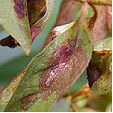
 Azalea
Azalea
Azalea (Rhododendron species) are susceptible to Leaf Scorch (Septoria azalea). This fungal disease forms reddish- brown spots which expand and engulf the leaf, with fruiting bodies appearing in the centre. Infected leaves die, then fall and the branchlets wilt. This problem is more serious during wet periods and may require control using a fungicide.
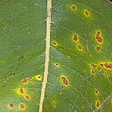 Banksia robur
Banksia robur
Banksia species are infected by several leaf spots causing chlorotic areas that have brown centres and is not normally a major problem for the plant.
Betula species may be infected by the Leaf Spots (Gloeosporium betularum) that forms brown spots with darker margins and (Cylindrosporium betulae) that also forms brown spots with faded indefinite margins.
Bougainvillea species are infected by the leaf spot (Cercosporidium bougainvilleae) which forms rounded spots with dark margins that yellowish ting. Infected leaves die and fall from the plant.
Calendula species are infected by the Leaf Spot (Cercospora calendulae) which rapidly infects the plant spotting the leaves and killing the plant.
Callicarpa species may be infected by the leaf spot (Atractilina callicarpae) forming irregular brownish spot or (Cercospora callicarpae) which can defoliate the plant in subtropical climates.
Campsis species may be infected by several fungal leaf spots including (Phyllosticta tecomae), (Septoria tecomae) and (Cercospora duplicata).
Carpinus species are infected by the leaf spots (Gloeosporium robergei), (Gnomoniella fimbriata) and (Septoria carpinea), all are minor infections not normally requiring control.
Carya species are infected by several leaf spots including (Gnomonia caryae) that infects leaves with irregular reddish spots on the upper surface with corresponding brown spore producing spots on the underside. It also has a secondary spore release that occurs on the dead leaves where it over winters. Other leaf spots include (monochaetia desmazierii) and (Marssonina juglandis).
Ceanothus species are susceptible to the leaf spot (Cercospora ceanothi) and (Phyllosticta ceanothi) both are of minor importance not requiring control.
Celtis species are infected by many leaf spots including (Cercosporella celtidis), (Cylindrosporium celtidis), (Phleospora celtidis) and (Septogloeum celtidis).
Chrysanthemums species are infected by the leaf spot (Septoria species) which forms yellow spots appear toward the edge of the leaves; these become enlarged brownish patches with yellow margins. Damaged areas may converge and in severe attacks and the leaves may fall prematurely or flower production is reduced.
Clematis species are infected by the fungal disease (Ascochyta clematidina) which may cause stem rot or leaf spots that are water soaked areas with reddish margins. The infection spreads from the leaves to the stem causing wilting and eventually girdling the stem killing the plant. There are many fungal leaf spots that infect this plant including (Cercospora rubigo) and (Septoria clematidis)
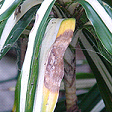 Dracaena deremensis
Dracaena deremensis
Cordyline and Dracaena species may be infected by the leaf spot (Phyllosticta maculicola) which forms small brownish spots that have yellowish margins and has black fruiting bodies that forms coils of spores. These plants are also susceptible to other leaf spots such as (Glomerella cincta) and (Phyllosticta dracaaaenae). Keep foliage dry to avoid infection.
Cynodon dactylon, Pennisetum clandestinum and many other Turf Grasses are susceptible to Helminthosporium Disease.
Daphne species are infected by the leaf spot (Gloeosporium mezerei) and (Marssonina daphnes) both of which form thickish brown spots that are seen on both sides of the leaves. Infected leaves turn yellowish before dieing.
Dendranthema species are infected by many leaf spots such as (Septoria chrysanthemi) which first forms yellowish spots up to 25mm (1in) across that become black. Infected leaves die prematurely and persist on the plant.
Dianthus species may be infected by the leaf spot (Septoria dianthi). It forms light brown rounded spots that have a purplish border. The scattered spots on the lower leaves can also be found on the stems and the spores are dispersed by water from the tiny black fruiting bodies.
Dieffenbachia species are infected by several leaf spot fungi including (Cephalosporium species) and (Myrothecium species).
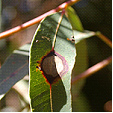 Eucalyptus species
Eucalyptus species
Eucalyptus species are infected by many fungal leaf spots such as (Mycosphaeralla species), (Hendersonia species) and (Monocheatia monochaeta). Generally leaf spots appear on the juvenile or new leaves causing brownish spots that enlarge and may have a purplish halo around the margin. Mature adult leaves are not normally infected and the trees rarely require control measures.
Fern species are infected by the leaf spot, (Alternaria polypodii). This fungus appears as brown circular or oblong spots that congregate along the margins of the pinnae causing the fronds to turn brown and die. It is spread by wind currents from plant to plant and control methods include removing infected fronds and maintaining a drier atmosphere.
Ficus species are infected by various fungal leaf spot including (Pseudocercospora species). Generally the fungal attack forms circular or irregular dark coloured spots on the leaves eventually causing them to fall prematurely.
Ficus elastica is susceptible to many fungal leaf spots including (Alternaria species), (Leptostromella elastica) and (Phyllosticta roberti).
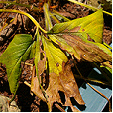
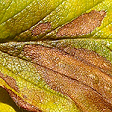 Strawberry
Strawberry
Fragaria x ananassa (Strawberry) is infected by the fungal leaf spot (Mycospharella fragariae). The mature leaf is initially infected with well defined brown spots that that turn light grey with red-purplish margins. As the spots merge they form large brown blotches and the leaf turns yellow then dies. This fungal attack normally occurs on plants in poor health and can be a serious problem early in the season seriously damaging stock.
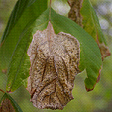 Fraxinus species
Fraxinus species
Fraxinus species are infected by the leaf spot (Gloeosporium aridum) giving the leaf a scorched appearance as large blotches appear from the margin or apex and turn brown with a papery texture. It is more prevalent during rainy periods and infected leaves fall prematurely. Collect and depose of fallen leaves otherwise control is not normally required.
Fuchsia species may be infected by the leaf spot (Septoria species) or ( Cercospora species), both form spots with dead centres and dark margins.
Gladiolus species are infected by Hard Rot or Leaf Spot (Septoria gladioli). On the corms reddish brown circular water soaked spots become large and sunken. These areas dry out and form obvious margins. The leaves may also have these symptoms but is not commonly seen.
Hemerocallis species are infected by several leaf spots including (Cercospora hemerocallis) and (Heterosporium iridis). These may be in the form of black spots or brownish spots that converge killing the leaf. Infected leaves should be removed and burnt.
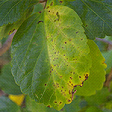 Hibiscus species
Hibiscus species
Hibiscus rosa-sinensis, Hibiscus syriacus and Hibiscus tiliaceus are susceptible to several fungal leaf spots including (Ascochyta abelmoschi), (Cerospora kellermanii) and (Phyllosticta hibiscina). All cause spotting or blotching of the leaf surface; remove and destroy infected parts.
Hydrangea species are infected by four fungal species including (Ascochyta hydrangeae), (Phyllosticta hydrangeae) and (Septoria hydrangeae).
Iris species are infected by several fungal leaf spots including (Alternaria iridicola) and (Macosphaerella species).
Iris species are also infected by the leaf spot (Didymellina macrospore) that forms greyish spots with brown water soaked borders and coalesce on the upper part of the leaf. This casual organism commonly occurs after flowering killing the leaves but will not infect the bulbs. The bulbs become weak over several seasons due to the decreased foliage.
There is also a Bacterial Leaf Spot (Bacterium tardicrescens) that is commonly mistaken as a fungal problem causing translucent spots that coalesce and involve the entire leaf. Normally found on Iris species.
Laburnum anagyroides is infected by the Leaf Spot (Phyllosticta cytisii). The leaf forms light grey spots with no definite margin and mature to brown. The black fruiting bodies appear as dots in the centre of the spot.
Leucanthemum species are infected by the leaf spot (Cerocspora chrysanthemi) and (Septoria leucanthemi).
Magnolia species are susceptible to many species including (Alternaria tenuis), (Mycosphaerella milleri) and (Phyllosticta species). Leaves generally turn brown from the apex or margins turning brown or spots appear on the leaf surface and leaves become yellow before withering and dieing. Normally the make the tree look poorly but have little effect on its growth. Control is not normally required.
Nerium oleander is susceptible to several fungal leaf spots including (Cercospora nerella), (Cercospora repens), (Gloesporium species) and (Phyllosticta nerii). Infected leaves should be removed but generally control is not required.
Nyssa sylvatica is infected by the leaf spot (Mycosphaerella nyssaecola) forming irregular purplish blotches.
Orchids such as Cattleya, Cymbidium, Cypripedium, Dendrobium, Epidendrum, Paphiopedilum, Phalaenopsis and Zygopetalum species are infected by several leaf spots including (Cerospora, Colletotrichum and Phyllosticta species). Normally forming dark or dead, circular or irregular areas on the leaves.
Palms such as Syagrus, Howea, Phoenix, Roystonea and Washingtonia species are infected by Leaf-scab (Graphiola phoeicis).
Palms such as Archontophoenix, Caryota, Chamaedorea, Cocos, Dypsis, Howea, Liculia, Linospadix, Livistona, Phoenix, Ptychosperma, Rhapis, Roystonea, Syagrus, Washingtonia and Wodyetia species are susceptible to several fungal leaf spots including;
(Bipolaris spp.), (Cylindrocladium spp.), (Colletotrichum spp.) and (Pestalotiopsis spp.).
Generally the circular leaf spots are brown and may have a yellow halo such as Palm Ring Spot (Bipolaris incurvata). They vary in size from small to large depending on the species. When a plant is healthy it recovers from attack, but heavy infections can defoliate, causing the collapse of the plant.
Palms are also infected by the Brachybasidium Leaf Spot (Brachybasidium pinangae). This fungus forms angular leaf lesions that produce fruiting bodies on the underside and is commonly found on Archontophoenix species.
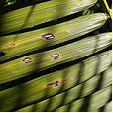
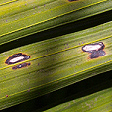 Archontophoenix cunninghamiana
Archontophoenix cunninghamiana
Passiflora species are infected with many types of leaf spot such as (Alternaria passiflorae).
Phoenix species are susceptible to False Smut (Graphiola phoenicis). This fungus forms yellow leaf spots that become hard with a raised with a blackish scab, which produces masses of powdery spores that are thread-like.
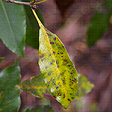
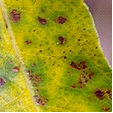 Pittosporum species
Pittosporum species
Pittosporum species are susceptible to the leaf spots (Alternaria tenuissima), (Phyllostica species) and (Cercospora pittospori). Circular or angular dark spots appear on the leaves and are surrounded by necrotic areas that are yellowish. Generally removal of infected leaves is adequate control.
Poa species and other cool season grasses are infected by Winter Fusarium Leaf Disease (Fusarium species), which causes small pale spots that are water soaked to appear on the leaves that turn red-brown. Infected leaves become bleached then wither and die, but the infection will not affect the crown or roots of the plant. It can be identified by pink, cotton-like mycelium and the plant prefers cold wet weather.
Populus species are infected by several fungal leaf spots including (Ciborinia bifrons, Ciborinia confundens), and (Mycosphaerella populicola).
Prunus species are infected by several leaf spots including (Cercospora circumscissa and Septoria ravenelii).
Pseudotsuga menziesii Douglas Fir is infected by the Leaf Cast (Rhabdocline pseudotsugae) Symptoms include the needles becoming yellowish at the apex and extending down the needle and spreading to others during moist spring weather turning them brown. Brownish scorched areas are noticeable on the tree from a distance. Control; is not normally required for mature trees but nursery stock may require spraying with a copper based fungicide.
Psidium guajava (Guava) is infected by (Glomerella cingulate). This fungus courses spots to appear on leaves and mummifies and blackens immature fruit or rots mature fruit. This fungus can devastate a guava crop.
Quercus species are infected by several types of leaf spot including (Cylindrosporium microspilum) and (Marssonina martini). These attacks tend top take place later in the season and normally not detrimental to the tree.
Rhododendron species are infected by a large variety of fungal leaf spots including (Cercospora rhododendri) and (lophodermium melaleucum)
Salix species are infected by several fungal leaf spots including (Ascochyta salicis) and (Septogloeum salicinum).
Senecio species are infected by the fungal leaf spot (Alternaria cinerariae) and (Cercospora species), forming dark rounded or angular spots.
Spiraea species are attacked by the fungal leaf spot (Cylindrosporium filipendulae).
Stenotaphrum secundatum (Buffalo) turf grass is susceptible to Grey Leaf Spot (Pyricularia grisea) in domestic and commercial situations devastating lawns. This fungal disease infects the stems and leaves with small brown lesions that enlarge rapidly forming grey-brown spots that have darker borders or surrounded by yellow chlorotic areas. This infection is commonly found on newly laid turf but will also infect established lawns. It is most prevalent during warm humid periods in soil with a high nitrogen level.
Syringa species are attacked by up to six species of leaf spot including (Cercospora lilacis) and (Phyllostica species).
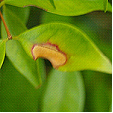 Syzygium species
Syzygium species
Syzygium species are infected by fungal leaf spots but normally control is not required.
Tagetes species are infected by the leaf spot (Septoria tageticola), which starts at the base and moves progressively up through the plant, covering the leaves in grey to black spots.
Trillium species are host to several leaf spots, including (Colletotrichum peckii) (Gloeosporium Trillii) (Heterosporium trillii).
Ulmus species are infected by many fungal leaf spots including (Gnomonia ulmea) and (Cercospora sphaeriaeformis).
Veronica species are infected by the leaf spot (Septoria veronicae). The symptoms include small violet to brown spots appear on the upper surface of the leaf and correspondingly yellowish brown on the underside. The spots converge forming a scorched shot-hole appearance and eventually death of the leaf.
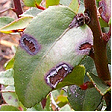 Vaccinium ovatum
Vaccinium ovatum
Vaccinium ovatum is infected by the leaf spot (Rhytisma vaccinii) and (Dothichiza caroliniana).
Vicia species are infected by the leaf spot (Erostrotheca multiformis), which forms greyish spots that enlarge and may defoliate the plant.
Wisteria species are infected by three fungal leaf spots (Phyllostica wisteriae), (Septoria wisteriae) and (Phomatospora wisteriae).
Non-chemical Control
Remove and destroy infected plant material and avoid overhead watering. When planting select infection resistant varieties. Practice crop rotation and add pot ash to the soil to decrease the plants venerability to the disease. Many species of fungus overwinter in fallen leaves, remove and destroy any litter under the plant.
Winter Fusarium Leaf Disease in Turf Grasses can be minimised by aerating the soil, reducing thatch and avoid excessive nitrogen in the soil.
Chemical Control
Protective fungicides such as zineb or copper oxychloride should be sprayed at the first sign of infection and cuttings should be sprayed as they start to grow.
Note
Always read the label for registration details and direction of use prior to application of any chemicals.
Average Lowest Temperature : -1º C 30º F
USDA : 9, 10, 11
This USDA (United States Department of Agriculture) hardiness zone chart can be used to indicate a plant’s ability to withstand average minimum temperatures. However, other factors such as soil type, pH, and moisture, drainage, humidity and exposure to sun and wind will also have a direct effect on your plant’s survival. Use this chart only as a guide, always keep the other factors in mind when deciding where, when and what to plant.
A plant's individual USDA zone can be found in the Plant Overview.
Climate Description
Warm to Sub-tropical
This overlaping zone has ample rain with high summer temeperatures and high humidity. Winters are mild. Pockets of sub-tropical climates exist within coastal warm temperate zones.
Frosts and droughts rarely occur along the coast.
Plant growth
Tropical and warm temperate native and exotic plants grow well.
| Dictionary | Growth Habit |
| Leaf Type | Botanic Flower Description |
| Leaf Shape | Flower Inflorescence |
| Leaf Arrangement | Fruit Type |
| Leaf Margin | Bark Type |
| Leaf Apex And Bases | Flower Description |